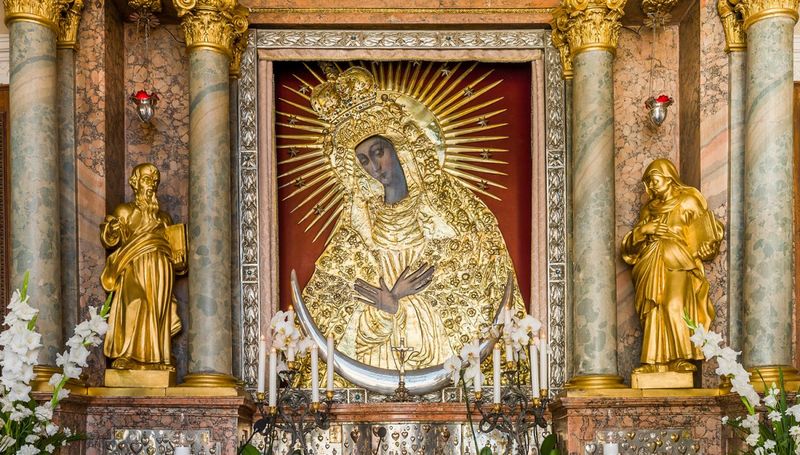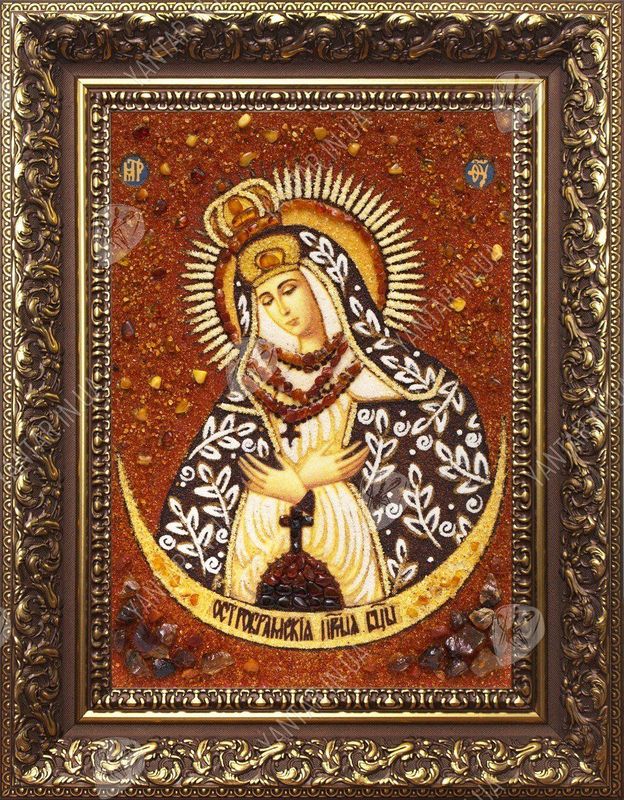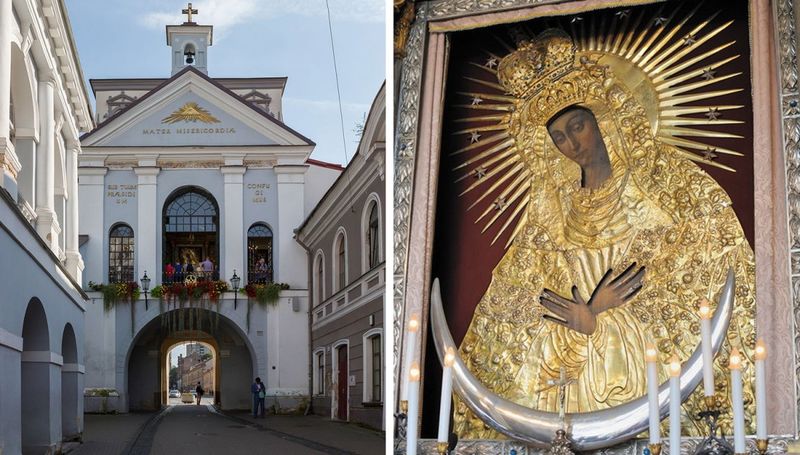

There are many relics of the Mother of God, which depict different aspects of Her image, serving as an example for believers. Thus, one of the sanctuaries demonstrates the devotion of the Immaculate Virgin to the Lord, her restraint, humility and willingness to rely on the will of the Creator. Our article and blog on yantar.ua web is dedicated to her, from which you will learn what the Virgin of Ostrobram became famous for, the meaning of the icon, as well as in which cases she is addressed.
There are several versions of the origin of the shrine. One of them testifies that the beautiful face of the Mother of God was sent to Vilnius - the capital of the Grand Duchy of Lithuania - by the Byzantium emperor John V Palaeologus. The image was presented to Olgerd Gedyminovich (1296-1377), who converted to Christianity. According to another tradition, the icon by divine desire appeared in the city on April 14, 1431. Historian Teodor Narbut, based on the works of canon Daniel Lodziata (XVII century), claimed that Bishop Olgerd brought the relic from Chersonesos (because of this it is sometimes called Korsunskaya), after which the ruler's wife Iuliania donated the image to the Church of the Life-giving Trinity. However, other sources contradict this - although in 1341-1373 the prince did organize several successful military campaigns against the Crimean Tatars, such a trophy is not listed in any census.
More likely is the hypothesis put forward by the researcher Mechyslav Skrudlik that the Ostrobram icon of the Mother of God was created in the 16th century. master Lukash Porenbskyi. This is evidenced by the similarity of the image with the relic from the Corpus Christi Church in Krakow. Other scholars attribute the authorship to an unknown Italian artist or the Dutch painter Martin de Vos, who were inspired by the face of the Madonna Immaculata - the Immaculate Virgin Mary.
Whichever theory is true, in 1431 the icon was already in the Trinity Church in the Russian district of Vilnius. And in 1498, fearing an attack by pagans, the townspeople laid new stone ramparts and a gate with a tower, in which the relic was erected. Because of this, she was called Ostrobramskaya.
The first written mention of the icon is found in the "Chronicle of the Monastery of the Barefoot Carmelites in Vilno". A short note tells about the transfer of the image to the chapel built in 1671. At the same time, the figure of the Mother of God was covered with a gilded silver cover, leaving only the face and hands visible. However, in the fire of 1711, the wooden building burned down. The relic saved from the fire was sent to the Carmelite church of St. Libra.
The shrine was placed back on the city wall at the beginning of the 17th century. Since then, it has been there almost constantly, although the building was damaged during the invasion of French troops in 1812. Moreover, when the Carmelite monastery was closed in 1832, the church belonging to the brothers was renamed Ostrobramskyi, and prayers in honor of the miraculous face of the Virgin Mary began to be served there . Therefore, when deciding where to keep a relic at home, people often prefer a place above the front door - it is believed that this way it will protect your home from any misfortunes and troubles.
In 1849, the icon was decorated with a silver crescent - a votive gift (an offering made as a sign of gratitude for the fulfillment of a wish). Engraved on the metal are the words "Dzięki Tobie żądam Matko Boska za wysłuchanie próśb moich, a prozę Cię, Matko Miłosierdzia, zachowaj mnie nadal w łasce i opiece Swojej Przenajświętszej W. I. J. 1849 roku", translated as: "I thank You, Mother of God, for who listened to my requests, and I ask You, Merciful Mother, to continue to protect me in Your Holy love and care." Other people who were healed or comforted by the grace of the relic left similar souvenirs - now it is even difficult to find a place in the chapel to hang another piece of jewelry or rosaries.
And in 1927, the Roman Pope Pius XI, at the request of the Vilnius archbishop, gave permission to crown the image, which was carried out on July 2. After the solemn ceremony, the shrine was placed in a special container that protects it from damage.
In the Orthodox Church, the relic is commemorated on January 8 (according to the old style - December 26). The Catholic holiday dedicated to this figure is celebrated on November 16.
The type of shrines in which the Immaculate Virgin is shown without the Son of God is known as Agiosoritissa. It is believed that the Creator is present on such an image invisibly - it is to him that the prayer of the Mother of God addresses. Such icons were widespread in Byzantine art of the XII-XV centuries, and later masters of the Western tradition began to create them.
The face of the Heavenly Queen of Ostrobram is also painted in this style. For this, tempera (powder paints that are diluted with water) was used, and the basis was two oak boards 2 cm thick. The characteristic features of the shrine are robes covered with rich ornaments and a double crown of the Madonna supported by cherubs, which symbolizes the power over the earth and the sky. A similar manner is characteristic of many baroque icons, as well as the rays of the sun radiating from the head of the Blessed Virgin.
Originally, the relic depicted the scene of the Annunciation, but the fragment with the image of the Archangel Gabriel has been lost - now the size of the shrine is 200x165 cm. However, this almost did not affect the content of the image - it is imbued with pacification, peace and serenity. Despite the fact that the fate of the Mother of God will not be easy (tears in Her eyes testify to the realization of this), She humbly and humbly accepts it, striving to fulfill her duty.
In addition, when listing what the shrine protects against, one should not forget about the numerous healings that occurred after believers bowed before the miraculous image. Most often, the relic relieves the symptoms of mental illness or mental suffering - depression, neurosis, apathy, despair. If you turn to her in a difficult moment, you will feel relief and support, you will be able to choose the right path, reject temptations and trials. Image also helps with physical ailments, relieving pain and strengthening health.
What do they pray before the icon? It protects against gossip, envy, tricks of ill-wishers and curses, prevents problems, danger and even sudden death. The relic brings an atmosphere of peace, happiness, and kindness to the house, allows you to achieve harmony and prosperity. This image has a particularly beneficial effect on spouses - it teaches them to overcome life's difficulties together, to show patience, understanding and forgiveness, to behave with dignity and wisdom. Also, the shrine admonishes children, guiding them on the righteous path and protecting them from bad influences.
And you can buy an icon of the Virgin Mary of Ostrobram in our online store "Amber Polissya". The relics of natural solar gems presented here are of high quality, spiritual and sublime, and they are also strong and durable.